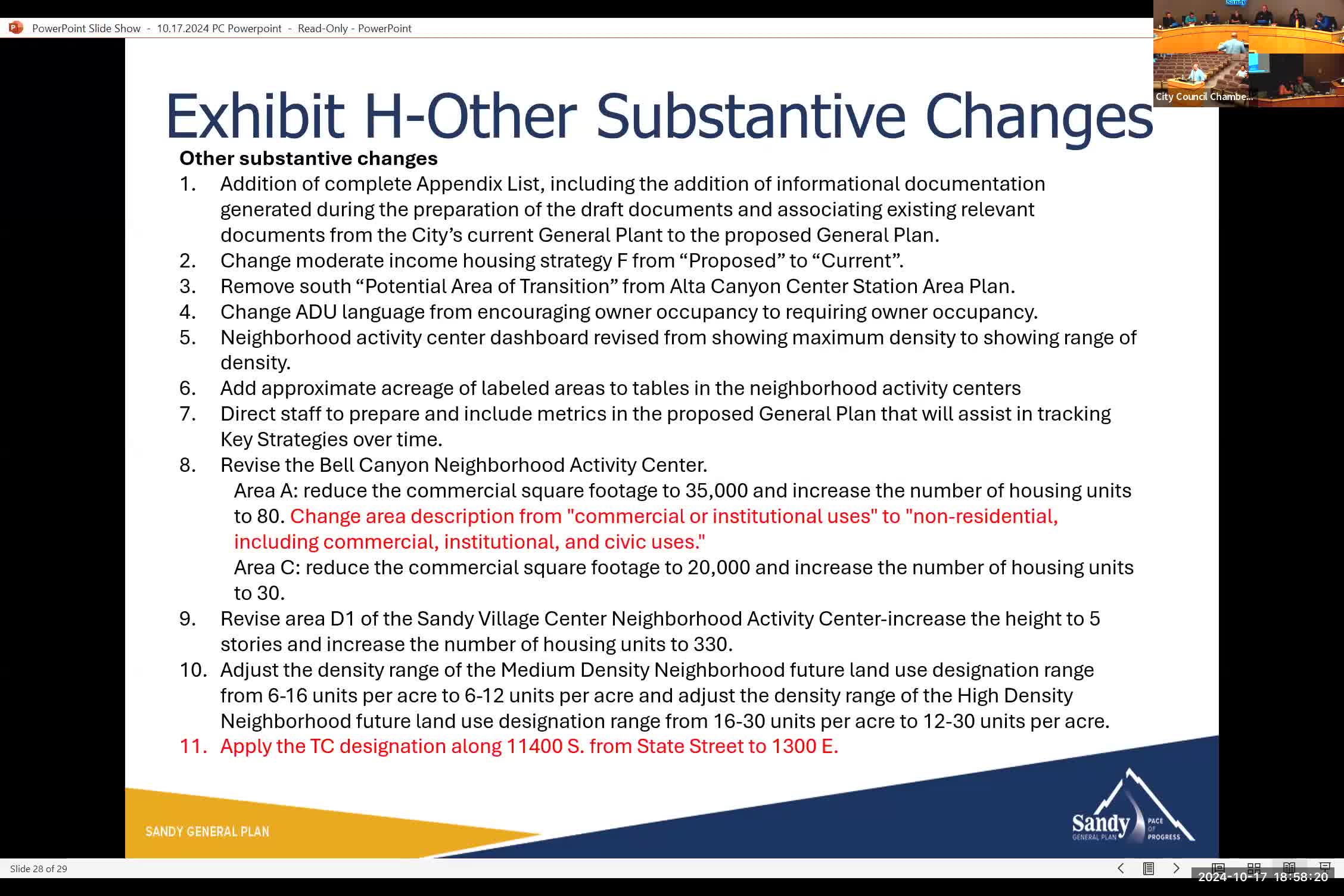Housing strategy overhaul aims to boost density and diversity
October 17, 2024 | Sandy City Planning and Zoning, Sandy, Salt Lake County, Utah
This article was created by AI summarizing key points discussed. AI makes mistakes, so for full details and context, please refer to the video of the full meeting. Please report any errors so we can fix them. Report an error »

In a recent government meeting, officials discussed significant updates to the housing strategy, focusing on adjustments to neighborhood activity centers and the proposed density ranges for various areas. The planning commission was urged to support a motion that would allow staff to continue refining metrics to track these key strategies over time.
One of the primary proposals included strengthening the language around owner occupancy for Accessory Dwelling Units (ADUs), shifting from an encouragement to a requirement. Additionally, there were discussions about modifying the commercial square footage in specific areas, such as reducing the proposed commercial space in Bell Canyon from 45,000 to 35,000 square feet while increasing housing units from 70 to 80. The intent is to promote a mix of nonresidential uses, including institutional and civic spaces, alongside commercial developments.
Further proposals included reducing commercial space in another area to 20,000 square feet and increasing housing units to 30. In the Sandy Village Neighborhood Activity Center, officials considered increasing building heights to five stories, potentially allowing for up to 330 housing units in one area. However, the final number of housing units will depend on the size of a planned public gathering space.
A notable change discussed was the adjustment of density ranges for medium-density neighborhoods, proposing a reduction from 6-16 units per acre to 6-12 units per acre, while high-density areas would shift from 16-30 units to 12-30 units per acre. This change aims to better align housing density with access to transportation corridors.
The meeting also addressed the addition of a transition corridor designation along 114th South, which had been overlooked in previous discussions. Lastly, minor corrections and clarifications were proposed to ensure consistency across various planning documents and to account for recent annexations.
These discussions reflect a concerted effort by local officials to refine housing strategies and enhance community planning, balancing residential needs with commercial and civic development.
One of the primary proposals included strengthening the language around owner occupancy for Accessory Dwelling Units (ADUs), shifting from an encouragement to a requirement. Additionally, there were discussions about modifying the commercial square footage in specific areas, such as reducing the proposed commercial space in Bell Canyon from 45,000 to 35,000 square feet while increasing housing units from 70 to 80. The intent is to promote a mix of nonresidential uses, including institutional and civic spaces, alongside commercial developments.
Further proposals included reducing commercial space in another area to 20,000 square feet and increasing housing units to 30. In the Sandy Village Neighborhood Activity Center, officials considered increasing building heights to five stories, potentially allowing for up to 330 housing units in one area. However, the final number of housing units will depend on the size of a planned public gathering space.
A notable change discussed was the adjustment of density ranges for medium-density neighborhoods, proposing a reduction from 6-16 units per acre to 6-12 units per acre, while high-density areas would shift from 16-30 units to 12-30 units per acre. This change aims to better align housing density with access to transportation corridors.
The meeting also addressed the addition of a transition corridor designation along 114th South, which had been overlooked in previous discussions. Lastly, minor corrections and clarifications were proposed to ensure consistency across various planning documents and to account for recent annexations.
These discussions reflect a concerted effort by local officials to refine housing strategies and enhance community planning, balancing residential needs with commercial and civic development.
View full meeting
This article is based on a recent meeting—watch the full video and explore the complete transcript for deeper insights into the discussion.
View full meeting

